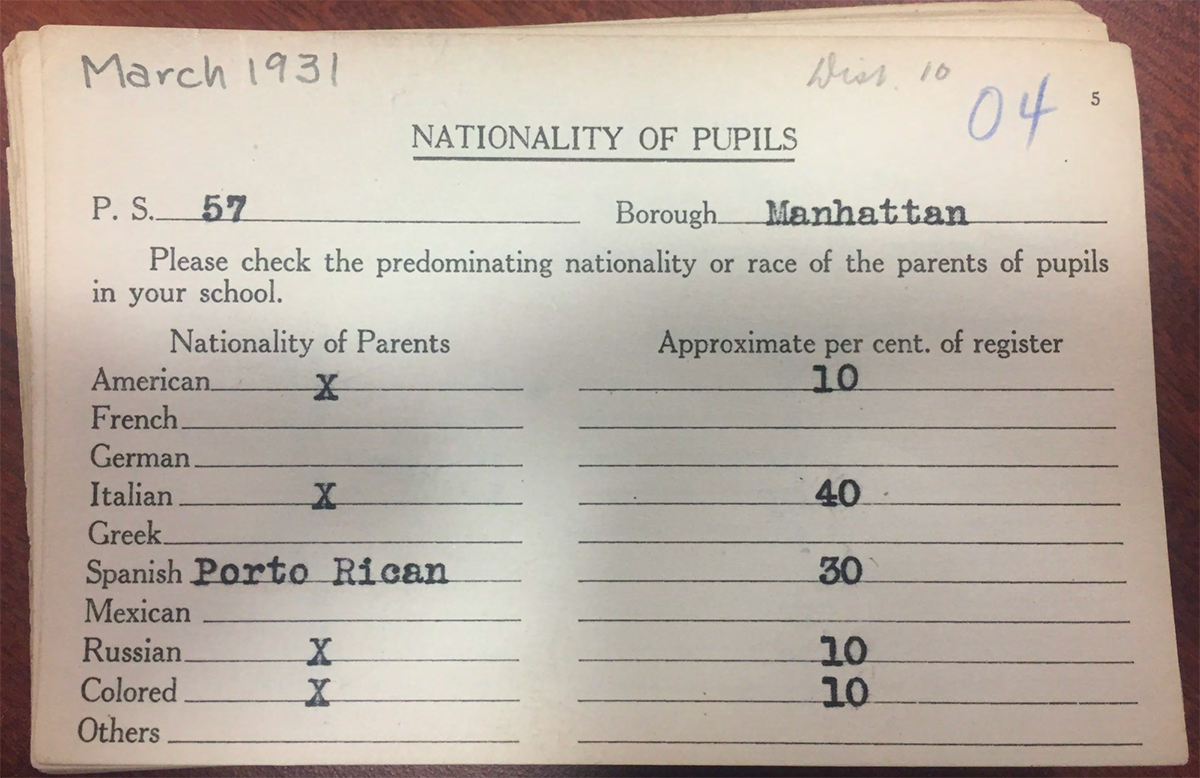Nationality of Pupils

Date: 1931
Caption: The Board of Education of the City of New York kept cards like these to count the number of students of different “nationalities” in each school.

Who were New York City’s students? This seemingly simple question became the focus of a citywide research project led by the Board of Education. From 1931 to 1947, the Board sent an index card like this one to each of its hundreds of schools. Those schools served a massive and still-growing population of students born in New York City, students who had been born outside the US (often in Europe or the Caribbean), and students who had been born in the US South and had participated in the Great Migration of African Americans to northern cities like New York. Through this migration, New York City’s small Black population grew very quickly in the 1910s, 1920s, and 1930s.1
This survey of “nationalities” was designed by education experts working in the centralized Board of Education. All or nearly all of these expert researchers were white people. The survey cards they created tell us more about the Board of Education and how they thought about their students than about the students themselves. What “nationalities” were the cards counting? Were these in fact “nationalities” - meaning a person’s country of origin? What motivated the Board of Education to conduct this survey?
These cards do give us some perspective on where New York City students came from. But they confuse ideas about “nationality” with ideas about race. In this period of time, more and more people who had previously been thought of as ethnically or even racially distinct from one another - Russians vs. Irish people vs. Italians, as examples - were increasingly categorized together under the label of “white.” And as white people, these groups could be confident that they would be recognized as US citizens, even when they had been born outside of the country or had parents who were. Yet some people who were US citizens since their birth, as established by the Fourteenth Amendment of the US Constitution, were not always perceived as citizens.2 The Board of Education seemed to doubt Black people’s citizenship when it separated Black (here labeled “colored”) citizens out from the category of “American” in 1931, and when it continued to distinguish between US citizens by racial categories in later years.
-
Museum of Modern Art, “Visualizing the Great Migration,” accessed March 25, 2024, https://www.moma.org/interactives/exhibitions/2015/onewayticket/visualizing-the-great-migration/. ↩︎
-
On the history of race and racial categories, see National Museum of African American History and Culture, “Talking about Race,” accessed March 25, 2024, https://nmaahc.si.edu/learn/talking-about-race/topics/historical-foundations-race, and Understanding Race, “European Immigration and Defining Whiteness,” accessed March 25, 2024, https://understandingrace.org/history/government/european-immigration-and-defining-whiteness-1910-1920/. ↩︎
Categories: K-12 organizing
This item is part of "From the “Masses” to “Experts”" in "Who Governs Schools?"
Item Details
Date: 1931
Creator: Board of Education of the City of New York, Bureau of Reference, Research, and Statistics
Source: Municipal Archives of the City of New York, Board of Education Papers
Copyright: Public domain
How to cite: “Nationality of Pupils,” Board of Education of the City of New York, Bureau of Reference, Research, and Statistics, in New York City Civil Rights History Project, Accessed: [Month Day, Year], https://nyccivilrightshistory.org/gallery/nationality-of-pupils.
Questions to Consider
- Who counts as an American, according to the New York City Board of Education in 1931? How does this definition of American compare to who was in fact a US citizen at the time?
- What does this document tell us about how the New York City Board of Education thought about its students at this time?
- How might this document have been influenced by or have been related to how school governance worked in New York City at the time?
References
How to Print this Page
- Press Ctrl + P or Cmd + P to open the print dialogue window.
- Under settings, choose "display headers and footers" if you want to print page numbers and the web address.
- Embedded PDF files will not print as part of the page. For best printing results, download the PDF and print from Adobe Reader or Preview.
